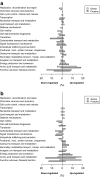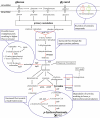Comparative transcriptomics and proteomics of p-hydroxybenzoate producing Pseudomonas putida S12: novel responses and implications for strain improvement
- PMID: 20449741
- PMCID: PMC2874742
- DOI: 10.1007/s00253-010-2626-z
Comparative transcriptomics and proteomics of p-hydroxybenzoate producing Pseudomonas putida S12: novel responses and implications for strain improvement
Abstract
A transcriptomics and proteomics approach was employed to study the expression changes associated with p-hydroxybenzoate production by the engineered Pseudomonas putida strain S12palB1. To establish p-hydroxybenzoate production, phenylalanine-tyrosine ammonia lyase (pal/tal) was introduced to connect the tyrosine biosynthetic and p-coumarate degradation pathways. In agreement with the efficient p-hydroxybenzoate production, the tyrosine biosynthetic and p-coumarate catabolic pathways were upregulated. Also many transporters were differentially expressed, one of which--a previously uncharacterized multidrug efflux transporter with locus tags PP1271-PP1273--was found to be associated with p-hydroxybenzoate export. In addition to tyrosine biosynthesis, also tyrosine degradative pathways were upregulated. Eliminating the most prominent of these resulted in a 22% p-hydroxybenzoate yield improvement. Remarkably, the upregulation of genes contributing to p-hydroxybenzoate formation was much higher in glucose than in glycerol-cultured cells.
Figures




Similar articles
-
Bioproduction of p-hydroxybenzoate from renewable feedstock by solvent-tolerant Pseudomonas putida S12.J Biotechnol. 2007 Oct 15;132(1):49-56. doi: 10.1016/j.jbiotec.2007.08.031. Epub 2007 Aug 23. J Biotechnol. 2007. PMID: 17900735
-
Improved p-hydroxybenzoate production by engineered Pseudomonas putida S12 by using a mixed-substrate feeding strategy.Appl Microbiol Biotechnol. 2011 May;90(3):885-93. doi: 10.1007/s00253-011-3089-6. Epub 2011 Feb 2. Appl Microbiol Biotechnol. 2011. PMID: 21287166 Free PMC article.
-
Repression of 4-hydroxybenzoate transport and degradation by benzoate: a new layer of regulatory control in the Pseudomonas putida beta-ketoadipate pathway.J Bacteriol. 1995 Dec;177(24):7033-40. doi: 10.1128/jb.177.24.7033-7040.1995. J Bacteriol. 1995. PMID: 8522507 Free PMC article.
-
Transcriptome analysis of a phenol-producing Pseudomonas putida S12 construct: genetic and physiological basis for improved production.J Bacteriol. 2008 Apr;190(8):2822-30. doi: 10.1128/JB.01379-07. Epub 2007 Nov 9. J Bacteriol. 2008. PMID: 17993537 Free PMC article.
-
Crude glycerol as feedstock for the sustainable production of p-hydroxybenzoate by Pseudomonas putida S12.N Biotechnol. 2014 Jan 25;31(1):114-9. doi: 10.1016/j.nbt.2013.08.006. Epub 2013 Aug 30. N Biotechnol. 2014. PMID: 23999132
Cited by
-
Integration of Genetic and Process Engineering for Optimized Rhamnolipid Production Using Pseudomonas putida.Front Bioeng Biotechnol. 2020 Aug 20;8:976. doi: 10.3389/fbioe.2020.00976. eCollection 2020. Front Bioeng Biotechnol. 2020. PMID: 32974309 Free PMC article.
-
The metabolic response of P. putida KT2442 producing high levels of polyhydroxyalkanoate under single- and multiple-nutrient-limited growth: highlights from a multi-level omics approach.Microb Cell Fact. 2012 Mar 20;11:34. doi: 10.1186/1475-2859-11-34. Microb Cell Fact. 2012. PMID: 22433058 Free PMC article.
-
Efflux systems in bacteria and their metabolic engineering applications.Appl Microbiol Biotechnol. 2015 Nov;99(22):9381-93. doi: 10.1007/s00253-015-6963-9. Epub 2015 Sep 12. Appl Microbiol Biotechnol. 2015. PMID: 26363557 Free PMC article. Review.
-
Biosynthesis of Hesperetin, Homoeriodictyol, and Homohesperetin in a Transcriptomics-Driven Engineered Strain of Streptomyces albidoflavus.Int J Mol Sci. 2024 Apr 5;25(7):4053. doi: 10.3390/ijms25074053. Int J Mol Sci. 2024. PMID: 38612864 Free PMC article.
-
Metabolic Engineering of Pseudomonas putida KT2440 to Produce Anthranilate from Glucose.Front Microbiol. 2015 Nov 24;6:1310. doi: 10.3389/fmicb.2015.01310. eCollection 2015. Front Microbiol. 2015. PMID: 26635771 Free PMC article.
References
-
- Ballerstedt H, Volkers RJM, Mars AE, Hallsworth JE, Santos VA, Puchalka J, van Duuren J, Eggink G, Timmis KN, de Bont JAM, Wery J. Genomotyping of Pseudomonas putida strains using P. putida KT2440-based high-density DNA microarrays: implications for transcriptomics studies. Appl Microbiol Biotechnol. 2007;75:1133–1142. doi: 10.1007/s00253-007-0914-z. - DOI - PMC - PubMed
Publication types
MeSH terms
Substances
LinkOut - more resources
Full Text Sources
Miscellaneous

